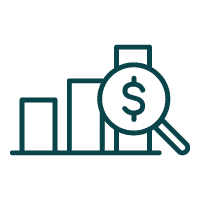The Power of Seamless Integrations: Reduce Burnout and Streamline Social Care Referrals
In the complex healthcare world, the last thing providers need is another login or system to navigate. At Findhelp, we believe that technology should simplify, not complicate. That’s why our commitment to advanced interoperability is central to our mission. Our seamless integrations empower healthcare and social service professionals to connect people with the help they need, all from within the systems they use every day.
In this post, you’ll learn:
What integration means and how the underlying technology works (in simple terms).
How a connected workflow eliminates duplicate efforts and reduces staff burnout.
Why integrated data is crucial for demonstrating ROI and succeeding in value-based care.
How one health system saved over $23,500 annually while dramatically improving staff satisfaction.
Defining integration
Integration lets different software systems “talk” to each other. For Findhelp users, this means our platform becomes an extension of your existing technology, whether it’s an electronic health record (EHR) like Epic or Oracle Health (Cerner), a care management platform, or another system of record.
With 50+ standard and custom options, our seamless integrations capability allows you to:
Search for local services
Find and connect people to social care programs without ever leaving your primary system.
Send and receive referrals
Securely send referrals and track their outcomes in real-time.
Automate documentation
Access social care information in the EHR for a complete view of an individual’s care.

The building blocks of connection: How we integrate
Technology integration isn’t a one-size-fits-all solution. To provide the most cohesive experience possible, we use a variety of modern, secure methods to connect with our partners’ systems. While the names sound technical, the concepts are simple:
- Native integration: Think of this as building Findhelp directly inside another platform. With this integration, users experience Findhelp as a natural feature of the system they’re already in, with no disruption to their workflow.
- Launch integration: This method places a secure button or link within your primary system. When clicked, it instantly opens the Findhelp platform, automatically logging the user in and carrying over relevant patient context. It’s a simple, secure bridge from one system to another.
- SMART on FHIR: This is the universal language of modern healthcare data exchange. SMART on FHIR acts like a secure key, allowing different applications (like Findhelp) to safely access necessary information from an EHR without requiring a custom-built connection. It’s a standardized, secure, and efficient way to plug and play.
- Webhooks: These are automated, real-time alerts between systems. When a referral is updated in Findhelp, a webhook instantly sends a notification to update the record. It ensures all connected systems stay perfectly in sync without any manual effort.
By using the right tool for the job, we ensure the connection is secure, reliable, and practically invisible to the end user.
The benefits of an integrated workflow
By embedding social care referrals directly into existing workflows, we help organizations achieve two critical goals: improving efficiency and supporting their staff.
1
Eliminate double work and boost efficiency
Without integration, the process of making a social care referral is manual and disjointed. A staff member might find a program for an individual, then have to manually enter that information into their primary system. It’s a recipe for duplicate data entry and potential errors.
Seamless integrations eliminate this redundancy. By connecting disparate systems, we create a single, streamlined process. This means your team can avoid jumping from system to system, saving valuable time that can be refocused on the people they serve.
2
Reduce staff burnout
When technology feels like a hurdle instead of a help, it adds to the cognitive load of already-strained teams. A seamless, integrated workflow reduces this friction. Staff can stay in their familiar digital environment, leading to a more intuitive and less stressful experience.
🖥️ Integration in Action: Becker’s Webinar | Aug. 27, 2025
See how Findhelp customer Trinity Health drove a 14% drop in preventable hospitalizations by integrating clinical & social care → Register today.
The impact of seamless integrations: A customer success story
The impact of this integrated approach is clear for a leading Pennsylvania health system that uses Findhelp. They tracked a dramatic improvement in efficiency when they moved from a manual process involving multiple systems and templates to a single, integrated workflow.
Based on a staff survey and analysis, they achieved:
✔️
Over $23,500 in annual cost savings due to improved staff efficiency.
✔️
59% reduction in the time needed to complete a transportation request (from 8.5 to 3.5 minutes).
✔️
67% decrease in monthly administrative emails.
✔️
100% staff agreement that it was harder to omit key information, leading to more complete referrals.
✔️
90% of staff reported fewer errors in requests.
✔️
77% of staff preferred the new, integrated process over the previous one.
From smoother workflows to smarter strategy
The benefits of integration extend beyond individual efficiency. With connected systems, your data becomes a clear guide for making strategic decisions that benefit your entire organization.
Unlock strategic insights with high-quality data
- Get data you can trust by eliminating the manual errors and gaps that undermine reporting.
- Enable true closed-loop reporting to track referrals from request to outcome, allowing you to strategically analyze results at scale.
- Demonstrate the ROI of social interventions on clinical metrics like hospital readmissions and identify crucial service gaps in your community.
Enhance security and build trust
- Link social care data into the clinical record, enabling more precise risk stratification and actionable population health strategies.
- Increase patient retention and loyalty by delivering the kind of coordinated, professional experience that builds lasting trust.
- Strengthen security and support HIPAA compliance with formal, auditable protocols for handling Protected Health Information (PHI).
Beyond workflows: Build a connected system of care
Our interoperability approach establishes the standard for integrated health and social care through:
- Member ingestion and eligibility display: We connect to Medicaid Member Information Systems and health plan member databases to display plan- and service-level information directly in an individual’s profile.
- Interoperable framework: We enable CBOs, care management partners, and others to use their preferred platform with point-to-point and secure exchange routing of referrals.
- Health information exchanges: We bidirectionally exchange data with approved regional and statewide health information exchanges, giving staff access to a longitudinal health and social care record.
By connecting systems and streamlining workflows, we can move towards a future of truly integrated care—one that is more efficient, effective, and sustainable for everyone involved.
Ready to build a more connected system of care?
Integrating your social care referrals isn’t just about adding a technical feature—it’s about fundamentally improving how care is delivered. It empowers your staff, provides the strategic data needed to prove impact, and creates a more connected, responsive experience for the people you serve. By eliminating the friction of today’s disconnected systems, you can free your organization to focus on what matters.
If you’re ready to move beyond fragmented workflows, explore our seamless integrations with leading systems like Epic, Oracle Health (Cerner), and MHK, contact us today for a personalized demo.








